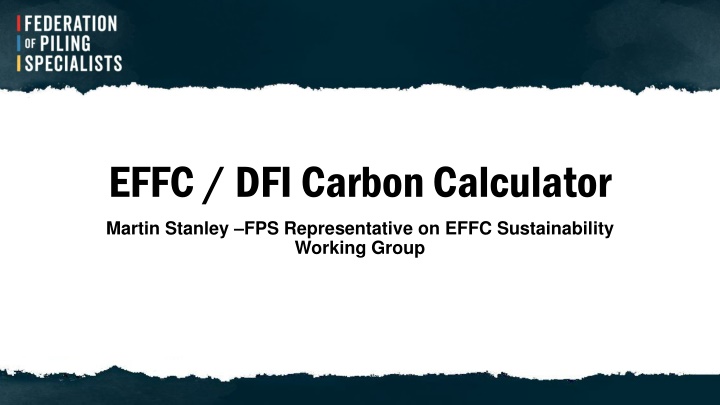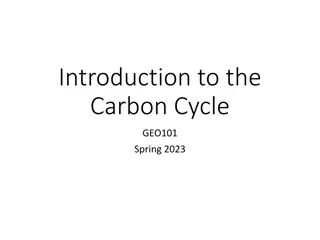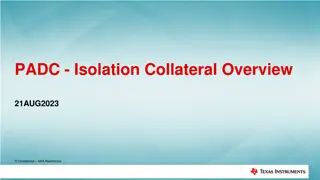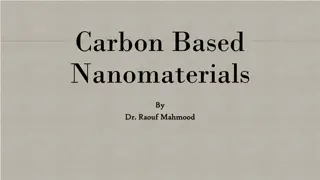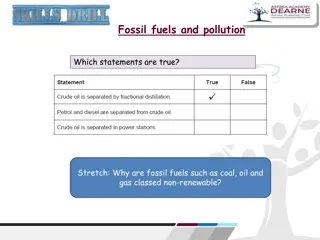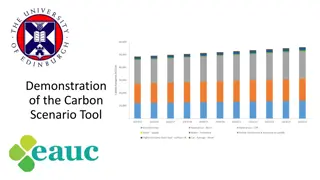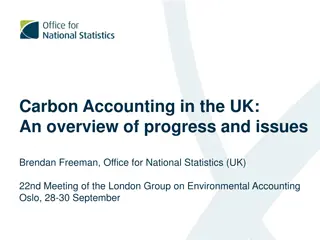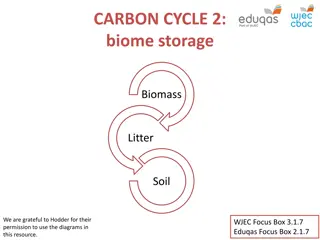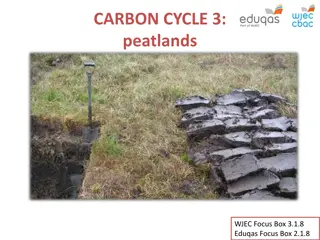Importance of Carbon Calculators in Deep Foundation and Ground Improvement Works
Climate change concerns have elevated the need for assessing carbon footprints. The EFFC/FPS members must account for carbon emissions to understand impacts, reduce energy dependence, quantify innovative techniques, and showcase environmental advantages. The introduction of a carbon calculator tool facilitates precise calculations, project comparisons, and compliance with potential legislative constraints on energy and emissions.
Download Presentation

Please find below an Image/Link to download the presentation.
The content on the website is provided AS IS for your information and personal use only. It may not be sold, licensed, or shared on other websites without obtaining consent from the author.If you encounter any issues during the download, it is possible that the publisher has removed the file from their server.
You are allowed to download the files provided on this website for personal or commercial use, subject to the condition that they are used lawfully. All files are the property of their respective owners.
The content on the website is provided AS IS for your information and personal use only. It may not be sold, licensed, or shared on other websites without obtaining consent from the author.
E N D
Presentation Transcript
EFFC / DFI Carbon Calculator Martin Stanley FPS Representative on EFFC Sustainability Working Group
Context Climate change is increasingly seen as a key issue by authorities and private companies The capability to evaluate carbon footprints is becoming more important and could become a potential differentiating factor in tenders and evaluating project performance and system / process improvements
Why should the EFFC / FPS Members account for Carbon Emission ? Understand the impact of deep foundations activities on climate change Reduce dependence on energy (Direct and Embodied) To quantify innovative technique / materials impacts To foster innovation regarding existing process and flows To demonstrate to customers the environmental (and normally commercial) advantage of some techniques / schemes compared to others
Why a Carbon Calculator ? In 2010 when this was first discussed there was no carbon calculator tool at European or International level for Deep Foundation and Ground Improvement Works Several National, European & International carbon standards and databases existed The need for a unique standard was identified Several carbon calculation tools had been developed by European companies but without any coordination
Why a Carbon Calculator Quantifying impacts is a key starting point in all improvement strategies A sector specific method and tool to improve the credibility of the calculations and confidence of customers
Provide all EFFC members with a carbon calculator for Deep Foundation and Ground Improvement Works, allowing for absolute calculation and project comparison Aims & Objectives of Building the Calculator Tool should be simple & open, though comprehensive + methodologically sound & usable by non-carbon specialists
Anticipate new legislative constraints on energy / emissions Prevent uncontrollable climate change Answer (or initiate new) customers needs Do like (or better than) your competitors Improve your image Develop marketing arguments Reduce your operational costs Motivate your teams working on customer service
Tender for support of carbon accounting specialist launched by EFFC / DFI Involvement of European wide team drawn from majority of EFFC/DFI member federations Development Process Strong UK involvement from Bachy Soletanche, BBGE, Cementation Skanska and Keller
Methodology : Calculating GHG Emissions: No carbon sensors Emission Factors Basic equation for assessing GHG emissions is as follows :
Secondary emission sources estimation Primary and secondary emission sources are estimated with different approaches Primary emission sources : Direct calculation based on activity data and specific emission factors Secondary emission sources : Possibility to use generic ratio or to bypass them with your own activity data
Emission Sources Material Manufacturing (Cement, Bentonite, Steel etc etc. Material Transportation from factory to construction site Energy Consumed on the construction site People s Transport to the construction site Equipment Transportation machines etc Equipment Manufacturing Waste Transportation from construction site to treatment site & Waste Treatment
Global Warming Potential The Global Warming Potential (GWP) measures a gas s contribution to warming the atmosphere over a period of time, usually 100 years, compared with CO2. It allows us to measure all types of GHGs with a single unit: CO2 equivalent (in kg, tons ). These GWP values are published regularly by the IPCC*.
What are the emission factors database used? EFFC-DFI Recommended database Materials Ecoinvent Bian Carbone Sustainableconcrete ICE Uni of Bath DEFRA DEFRA IEA A specific EFFC- DFI recommended database has been built from different databases Energy Transportation DEFRA EcoTransit Assets Bilan Carbone
Techniques Covered Bored piles Displacement piles Micropiles Diaphragm & Slurry Walls Sheet Pile Walls Soil Mixing Grouting Bored Pile Walls Anchors Soil Nails Dynamic Compaction Vibro Compaction Jet Grouting Stone Columns Vertical Drains Dewatering Underpinning Horizontal Drilling
Sampling: Bored Pile Example 100% 2 main primary sources : Materials (94%) Energy (4%) 90% 80% 70% Secondary sources (2%) : Freight Mob/Demob People Transportation Assets Waste 60% 50% waste 40% assets people transportation mob/demob 30% 20% freight materials 10% 0% Bored piles 1 Bored piles 2 Bored piles 3 Bored piles 4 Bored piles 5 Bored piles 6 Bored piles 7 Bored piles 8 Bored piles 9 energy
Prioritisation of emission sources 100% 90% 80% 70% 60% waste 50% assets 40% 30% people transportation 20% mob/demob 10% freight 0% energy Sheet pile walls Bored piles Displacements piles Soil Nails Micropiles Pile walls Jet grouting Soil Mixing Anchors Grouting Vertical Drains Stone Columns Diaphragm and slurry walls materials Primary emission sources Secondary emission sources are estimated with techniques specific ratios that can be replaced by real field data
General Principles of the EFFC method Relevance By using a project-based carbon calculator, companies are able to compare the carbon footprints of their different techniques and promote low-carbon offers to their customers. The tool calculates the carbon footprint of projects based on real activity data, ensuring the relevance of the calculation made. Completeness The tool always considers the same perimeter. The emission sources that are not calculated using activity data are estimated based on statistical data obtained from various relevant projects and made publicly available. Consistency Emission factor databases will have to be updated regularly by the EFFC to keep the tool up to date and to ensure comparability of the calculation made with other similar approaches.
General Principles of the EFFC method Transparency A Microsoft Excel based tool has the advantage that all the calculations are visible. All the values already in the tool are sourced with no black box approach. The methodology discloses all the assumptions and the tool is transparent (all emission factors are documented with complete references and from public sources). As a consequence of this principle, all emission factors integrated by the user must also be transparently sourced. (Supply Chain Help ) Accuracy This principle is integrated by evaluating an emission source s importance for the covered techniques. The uncertainty is evaluated and simple ratios proposed for secondary emission sources.
Tool Structure The tool aims to calculate the carbon footprint of a deep foundation or ground improvement project. A project can be subdivided into different subprojects. Each of these subprojects corresponds to the use of one of the deep foundation techniques. Projects are created simply by adding as many subproject worksheets as required for each technique used in the project. The tool allows comparisons at all levels, enabling the user to select the techniques with the lowest associated emissions and to compare the performance of different solutions for the same customer need
Tool Structure Totalisation sheet 250 kgCO2 One technique on one sheet 250 kgCO2@ 250 kgCO2 250 kgCO2 250 kgCO2 250 kgCO2 250 kgCO2 250 kgCO2 Emission sources by decreasing order of importance 250 kgCO2 250 kgCO2 250 kgCO2 250 kgCO2 250 kgCO2 250 kgCO2 250 kgCO2 Energy Materials 3000 kgCO2 Freight 120 kgCO2 250 kgCO2 Secondary sources with default ratios that can be replaced by real values 250 kgCO2 250 kgCO2 250 kgCO2 250 kgCO2
The Benefits.. Once you measure the footprint of your projects / techniques / materials you can target reducing it You can use the tool to drive innovation and find alternatives materials and techniques and measure tangible benefits The comparison sheet allows promotion of alternative, lower-carbon schemes Ultimately carbon costs money, either via material usage, energy costs or potentially increasing taxes/levies on pollution / waste etc We all have a civic duty to protect the future.
